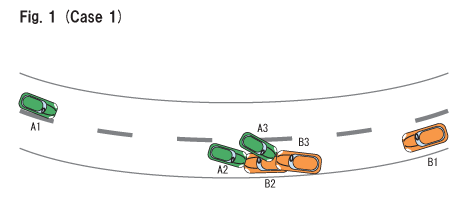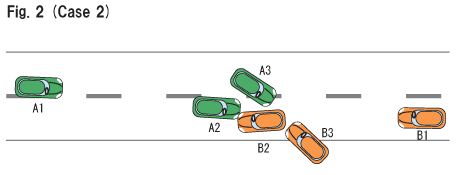
|
Case 1 (Fig. 1)
- Outline of Accident
Car A (light passenger car classified under Japan's light vehicle standard; female driver in her 50s) was traveling at about 40 km/h on a 6-m-wide, two-lane road at around 3 o'clock on a clear afternoon. Tired and sleepy, the driver strayed into the opposite lane and crashed into Car B (ordinary-size passenger car; male driver in his 60s) coming from the other direction.
|
- Accident Pattern
Vehicle-to-vehicle, frontal collision
|
- Year of Vehicle's First Registration, Vehicle Weight
Car A (Photos 1 and 2): 2004, light passenger car, 905 kg
Car B (Photos 3 and 4): 1998, ordinary-size passenger car, 960 kg
|
- Degree of Injury
Car A driver (with airbag; seatbelt fastened): Slightly injured
Car B driver (with airbag; seatbelt not fastened): Seriously injured
Car B passenger (no airbag; seatbelt not fastened): Seriously injured
|
|

|
|
|
|
|
|
- Discussion
When a light passenger car and ordinary-size passenger car collide, it is generally assumed that the occupants of the light car suffer greater injury. In this case, however, the driver of Car A sustained only minor injury, thanks to the fact that she was correctly wearing her seatbelt and that the car was equipped with airbags. Also, as shown in Photo 1, the front part of Car A was smashed to effectively absorb the shock of collision, as the car design intended, reducing the impact on the driver and inflicting only minor bruising. On the other hand, the driver and passenger of Car B were seriously injured: knee and hand fractures. The greater degree of injury suffered by Car B's occupants was due partly to the vehicle's deformation that reduced the passenger-compartment space (Photo 4), although the failure to wear seatbelts and the lack of an airbag on the passenger side (due to the 6-year gap in vehicle design) also played a role.
|
|
Case 2 (Fig. 2)
- Outline of Accident
Car A (light passenger car; female driver in her 20s) was traveling on a 6.4-m-wide, two-lane road at 50 km/h at around 10 o'clock on a cloudy night. The driver dozed off at the wheel and strayed into the opposite lane. The car collided in an offset frontal manner with Car B (light passenger car; female driver in her 30s) that was approaching in the opposite lane.
|
- Accident Pattern
Vehicle-to-vehicle, frontal collision
|
- Year of Vehicle's First Registration, Vehicle Weight
Car A (Photos 5 and 6): 2004, light passenger car, 905 kg
Car B (Photos 7 and 8): 1999, light passenger car, 885 kg
|
- Degree of Injury
Car A driver (with airbag; seatbelt fastened): Seriously injured
Car B driver (with airbag; seatbelt fastened): Seriously injured
|
|

|
|
|
|
|
- Discussion
This accident, although classified under "frontal collision", was an offset crash. Offset collisions generally inflict serious damage to the car's passenger compartment, because significant force is applied to one side of the vehicle's front. Comparing Photos 5 and 7, Car A is apparently less deformed, with the right front pillar remaining undamaged. This is the typical manner in which new models are smashed in an accident. During the development phase of new cars, computer simulations and crash tests are conducted repeatedly to determine how to absorb the impact of collision for improved safety of car occupants.
The driver of Car A, although classified as "seriously injured" because the duration of medical treatment exceeded 30 days, sustained only a fractured collarbone, a relatively minor wound in the "serious injury" category. The driver of Car B, on the other hand, suffered a broken thighbone even though she was wearing her seatbelt, presumably because the passenger compartment of her car was crushed (8).
|
|
|
UP
Back Next
|
